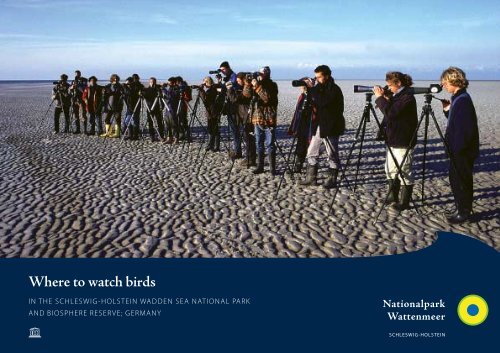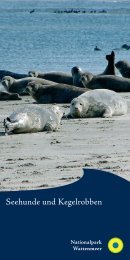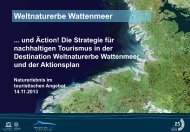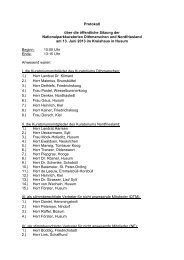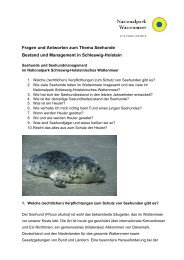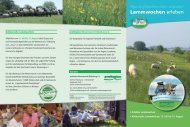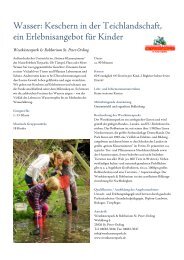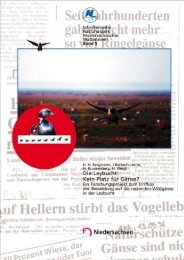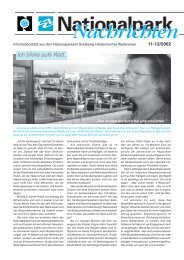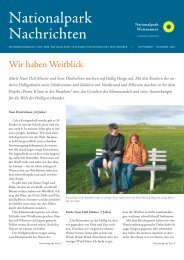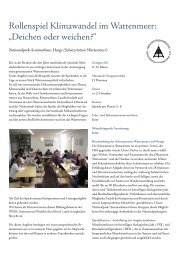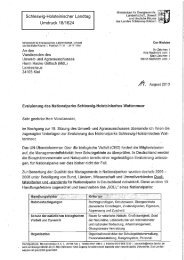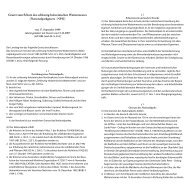Where to watch birds - Nationalpark Wattenmeer
Where to watch birds - Nationalpark Wattenmeer
Where to watch birds - Nationalpark Wattenmeer
You also want an ePaper? Increase the reach of your titles
YUMPU automatically turns print PDFs into web optimized ePapers that Google loves.
<strong>Where</strong> <strong>to</strong> <strong>watch</strong> <strong>birds</strong><br />
IN THE SCHLESWIG-HOLSTEIN WADDEN SEA NATIONAL PARK<br />
AND BIOSPHERE RESERVE; GERMANY
A paradise for <strong>birds</strong> and bird<strong>watch</strong>ers<br />
The Wadden Sea, which stretches from the Netherlands <strong>to</strong><br />
Denmark, is one of the most important wetlands for migra<strong>to</strong>ry<br />
water<strong>birds</strong> on earth. It provides a rich food supply for 10-12<br />
million <strong>birds</strong> (2 million geese and ducks, 7 million waders, 2<br />
million gulls and terns), which use the Wadden Sea for moult,<br />
wintering and <strong>to</strong> build up fat reserves before migration <strong>to</strong> distant<br />
breeding and wintering grounds. The majority, approximately<br />
10 million, are migra<strong>to</strong>ry <strong>birds</strong>, which refuel in the Wadden Sea<br />
during spring and autumn migration. In summer they migrate <strong>to</strong><br />
their breeding areas in the arctic tundras, which cover an area<br />
from north-eastern Canada <strong>to</strong> northern Siberia. A large<br />
proportion of the <strong>birds</strong> that pass through the Wadden Sea spend<br />
the winter in western or southern African coastal wetlands.<br />
However, many <strong>birds</strong> also remain in Europe and winter in the<br />
Wadden Sea itself or in the coastal wetlands of Great Britain,<br />
France and the Mediterranean area. The Wadden Sea is the single<br />
largest staging area on the East Atlantic Flyway; the migration<br />
route connecting wetlands from the arctic <strong>to</strong> the tropics and even<br />
Antarctica. The Wadden Sea is also home <strong>to</strong> approximately one<br />
million breeding waders, gulls, terns and numerous other coastal<br />
species.<br />
1,2 Mio.<br />
J F M A M J J A S O N D<br />
Half monthly <strong>to</strong>tals of <strong>birds</strong> in the<br />
Schleswig-Holstein Wadden Sea area.<br />
... during the year<br />
Although you can observe<br />
water<strong>birds</strong> throughout the<br />
year in the Wadden Sea, they<br />
are most numerous in spring<br />
and autumn. The period from<br />
March until the middle of May<br />
is the best time for <strong>watch</strong>ing<br />
Brent and Barnacle Geese. In<br />
May arctic waders are present<br />
in huge numbers before they<br />
leave for their breeding grounds (e.g. Grey Plover, Red Knot,<br />
Dunlin and Bar-tailed Godwit). Than they can be observed in full<br />
breeding-plumage. Local breeding <strong>birds</strong> are present from April<br />
through till August (Oystercatcher, Pied Avocet, Common<br />
Redshank, gulls and terns). They can be observed best on the<br />
small islands called „Halligen“, where gulls and terns form large<br />
colonies and several wader species (Oystercatcher, Common<br />
Redshank) breed in high densities.<br />
-2-
After breeding 200 000 Shelducks gather on the tidal flats of the<br />
Elbe estuary in the southern part of the Wadden Sea <strong>to</strong> moult.<br />
This concentration of <strong>birds</strong> represents a large proportion of the<br />
northwestern European population of this species. During the<br />
moulting period from July <strong>to</strong> September the <strong>birds</strong> are flightless<br />
and very sensitive <strong>to</strong> human disturbance.<br />
In late June the first water<strong>birds</strong> return <strong>to</strong> the Wadden Sea from<br />
their nordic breeding grounds. In August and September huge<br />
flocks of arctic waders can again be observed feeding and roosting<br />
on the tidal flats and saltmarshes of the region. From September<br />
onwards geese and ducks arrive and can be observed feeding on<br />
the saltmarshes. Numerous <strong>birds</strong> also stay in the Wadden Sea<br />
during the cold northern winter. The seasonal occurance of<br />
several selected species in the Wadden Sea is presented in the<br />
figures on pages 19 and 20.<br />
... during the day<br />
The daily activity of <strong>birds</strong> in the Wadden Sea is ruled by the tides.<br />
During high tide, when the tidal flats are covered by water, <strong>birds</strong><br />
gather in huge flocks <strong>to</strong> roost on saltmarshes and sandbars and in<br />
inland polders with wetlands. The best time for bird<strong>watch</strong>ing is in<br />
Contents<br />
The National Park and the Biosphere Reserve page 6<br />
Best birding sites page 8<br />
Birds through the year page 18<br />
Bird checklist page 21<br />
Annual events page 35<br />
Map<br />
back cover<br />
Seals on a sandbank: It is always<br />
possible <strong>to</strong> see some of the 10 000<br />
seals that breed in the region.<br />
East Atlantic Flyway of coastal <strong>birds</strong>.<br />
▼<br />
-3-
the early morning and late evening hours when this coincides with<br />
a high tide. Then you have the most favourable light conditions<br />
and the <strong>birds</strong> will be concentrated near <strong>to</strong> the coast. During low<br />
Low dykes protect the small Hallig islands from flooding during the summer<br />
months. The houses are built on mounds <strong>to</strong> protect them from exceptionally high<br />
tides. All the Hallig islands are ideal for bird <strong>watch</strong>ing.<br />
tide almost all <strong>birds</strong> are out<br />
searching for food on the<br />
extensive tidal flats and most<br />
of them are out of sight.<br />
However, even then it is<br />
exciting <strong>to</strong> <strong>watch</strong> the aerobatics<br />
of distant flocks of Red Knot<br />
and other waders on the<br />
horizon.<br />
Please be aware of the local<br />
tides: most mud flats are Telescopes will help you see more in<br />
flooded already two hours the open Wadden Sea landscape.<br />
before high tide! You should<br />
arrive at your chosen observation point well in advance.<br />
<strong>Where</strong> <strong>to</strong> <strong>watch</strong>?<br />
The different bird species are not distributed evenly throughout<br />
the Wadden Sea. For example most Brent Geese are found on the<br />
„Halligen“, while Barnacle Geese are concentrated along the<br />
mainland coast. Avocets prefer mud flats on the coast and<br />
Sanderlings choose sand flats on remote sandbars and<br />
sandbanks.<br />
-4-
During the last decades, several polders with large wetlands have<br />
been established along the coast through the embankement of<br />
tidal flats and saltmarsh areas. Although this led <strong>to</strong> a loss of<br />
feeding areas for many typical Wadden Sea <strong>birds</strong> <strong>to</strong> some extend,<br />
they still use the polders during high tide for feeding and roosting.<br />
The freshwater habitats created in these polders have become<br />
essential feeding, breeding, moulting and wintering areas for a<br />
great variety of waterbird species.<br />
The Schleswig-Holstein Wadden Sea offers numerous sites<br />
with excellent conditions for bird<strong>watch</strong>ing. The <strong>to</strong>p birding<br />
spots are described on pages 8-17.<br />
In many cases the crown of the dyke is the best vantage point <strong>to</strong><br />
<strong>watch</strong> <strong>birds</strong> from. It offers good views over the saltmarshes<br />
which lie in front of the dykes and where many <strong>birds</strong> roost<br />
during hightide; often quite near <strong>to</strong> the dyke. Observation<br />
<strong>to</strong>wers and hides are provided at some inland wetlands.<br />
Please respect nature<br />
A flock of shore<strong>birds</strong> in front of the Westerhever lighthouse on the Eiderstedt<br />
peninsula.<br />
Please respect nature when observing <strong>birds</strong> in the field and<br />
do not disturb breeding or roosting <strong>birds</strong>, keep <strong>to</strong> the tracks<br />
on the dykes and only use marked paths through the<br />
protected saltmarshes <strong>to</strong> reach the tidal flats. Do not enter<br />
areas signposted as protection zones for breeding and<br />
roosting <strong>birds</strong> and keep sufficient distance <strong>to</strong> flocks of<br />
roosting <strong>birds</strong> and colonies of breeding <strong>birds</strong> <strong>to</strong> avoid<br />
unnecessary dirsturbance. Please retreat immediately when<br />
you recognise that you have disturbed <strong>birds</strong> or other<br />
animals in the National Park.<br />
-5-
The National Park<br />
Almost the entire European landscape was transformed by<br />
human activities already in the Middle Ages. Only two areas<br />
remained largely unaffected by these changes: the high regions of<br />
the Alps and the Wadden Sea on the North Sea coast. Although<br />
humans have built dykes and embankments on the coast for<br />
centuries, the extensive tidal flats remain one of Europe’s<br />
primordial landscapes.<br />
In addition <strong>to</strong> its largely pristine character the Wadden Sea is of<br />
primary importance as a nature conservation area because of the<br />
flora and fauna of its saltmarshes and its importance <strong>to</strong> <strong>birds</strong> on<br />
the East Atlantic Flyway. Two hundred and fifty animal species<br />
are endemic <strong>to</strong> the saltmarshes, which form a narrow border<br />
along the Wadden Sea coast. The Wadden Sea is broadest in<br />
Schleswig-Holstein between the river Elbe and the border <strong>to</strong><br />
Denmark. Here tidal flats dotted with islands extend for<br />
35 kilometres from the coast <strong>to</strong> the sea. This offers exceptionally<br />
favourable conditions for a huge variety of bird and other animal<br />
species and makes the Wadden Sea one of the most important<br />
bird areas in Europe. This was the main fac<strong>to</strong>r leading <strong>to</strong> the<br />
establishment of the Schleswig-Holstein Wadden Sea as a<br />
National Park in 1985. Two further German Wadden Sea<br />
National Parks exist west of the river Elbe in Lower Saxony (est.<br />
1986) and Hamburg (est. 1990).<br />
The Schleswig-Holstein Wadden Sea National Park, which<br />
covers 4 400 square kilometres, is the largest National Park <strong>to</strong><br />
be found between the North Cape and Sicily. All three German<br />
Wadden Sea National Parks are Wetlands of International<br />
Importance (Ramsar Sites), Special Protection Areas according<br />
<strong>to</strong> the EU Birds Directive and have been proposed as Special<br />
Areas of Conservation according <strong>to</strong> the EU Habitats Directive.<br />
The Biosphere Reserve<br />
The Schleswig-Holstein Wadden Sea is, in combination with the<br />
Hallig islands, a UNESCO Biosphere Reserve. These reserves<br />
cultivate a balanced relationship between human use and natural<br />
cycles. By promoting sustainable regional economic development,<br />
they contribute <strong>to</strong> improved economic utilization of their terri<strong>to</strong>ry.<br />
-6-
„<strong>Where</strong> the sea floor meets the horizon“ is the slogan of the National Park.<br />
-7-
Best birding sites<br />
The best birding sites are listed with general information on the areas and their bird habitats. The list includes information<br />
on the species you can expect <strong>to</strong> see and when and where you are most likely <strong>to</strong> see them. If a site is important for a<br />
particular species or if a species occurs in especially large numbers this is indicated. Don’t forget, however, that <strong>birds</strong> can be<br />
seen throughout the year at all sites! Locations are indicated in the map on the back cover. For more information please<br />
contact the local warden, ranger or NGO.<br />
Islands and Halligen<br />
A <strong>to</strong>tal of 350 pairs of Little Tern breed on the islands.<br />
1 Sylt: Königshafen near List<br />
A Wadden Sea bay with two sandbars (Uthörn and Lister<br />
Haken) which lies north of the <strong>to</strong>wn of List. Roosting <strong>birds</strong> can<br />
best be observed from the dyke situated near <strong>to</strong> the sandbars.<br />
The sandbars are protection areas and access is forbidden!<br />
Wildfowl and other freshwater species can be viewed in the polder<br />
„Lister Koog“.<br />
March-May: Bar-tailed Godwit and Red Knot; June-August:<br />
Whimbrel and terns.<br />
i NABU, Dr. Asmus (+49 (0)4651 956127),<br />
www.nabu-sh.de<br />
-8-
2 Sylt: Rantumbecken<br />
A former Wadden Sea bay which was embanked in 1938. It<br />
includes a large shallow lake with brakish water and reedbeds.<br />
You can walk around the area on a path on the dyke, which is<br />
also an ideal vantage point for <strong>watch</strong>ing <strong>birds</strong> on the tidal flats,<br />
especially during rising and falling tides. The adjacent marshes at<br />
Nössekoog hold breeding Lapwings and Black-tailed Godwits in<br />
summer.<br />
March-May: Great Bittern, Greylag Goose, Red-breasted<br />
Merganser, Bar-tailed Godwit, Red Knot and Bearded Tit.<br />
i Verein Jordsand, Eidum Vogelkoje (+49 (0)4651 5812),<br />
info@jordsand.de<br />
3 Sylt: Westerland-Beach / North Sea<br />
Many sea<strong>birds</strong> can be seen on migration on the sea west of Sylt,<br />
especially in winter or during s<strong>to</strong>rmy periods. Search for sheltered<br />
vantage points for sea-<strong>watch</strong>ing along the Westerland seafront.<br />
August-November: Divers, Northern Gannet, Northern<br />
Fulmar, Shearwaters, Common Scoter, Black-legged Kittiwake,<br />
terns.<br />
4 Sylt: Hörnumer Nehrung<br />
A sandbar northeast of Hörnum, which lies adjacent <strong>to</strong> natural<br />
dunes.<br />
March-May: Common Eider, Bar-tailed Godwit and Red Knot;<br />
July-September: Sandwich Tern.<br />
i Schutzstation <strong>Wattenmeer</strong>, Hörnum (+49 (0)4651 881093),<br />
hoernum@schutzstation-wattenmeer.de<br />
5 Amrum: East coast<br />
between Norddorf und<br />
Amrum Odde<br />
The narrow strip of saltmarshes<br />
in front of the dyke<br />
northeast of Norddorf is the<br />
main feature of this site. The<br />
dyke is a good vantage point<br />
for bird<strong>watch</strong>ing, especially if<br />
you want <strong>to</strong> observe <strong>birds</strong><br />
close in at high tide. The light<br />
conditions are best in the<br />
afternoon at this site. It is also<br />
worth searching for meadow<br />
<strong>birds</strong> on the inland marshes.<br />
The Black-headed Gull is the most<br />
common breeding bird in the Wadden<br />
Sea. 35 000 pairs breed in the area.<br />
-9-
April-May and July-September: Huge flocks of waders,<br />
especially Eurasian Curlews, inhabit the area in spring and<br />
autumn.<br />
i Schutzstation <strong>Wattenmeer</strong>, Wittdün (+49 (0)4682 2718),<br />
amrum@schutzstation-wattenmeer.de<br />
Öömrang Ferian, Norddorf (+49 (0)4682 1635),<br />
naturzentrumnorddorf@gmx.de<br />
Verein Jordsand, Amrum Odde (+49 (0)4682 2332),<br />
info@jordsand.de<br />
6 Amrum: Kniepbucht<br />
south of Wittdün<br />
A bay at the southern end of a<br />
huge sandbar, the<br />
„Kniepsand“, which is situated<br />
in front of the Wittdün<br />
seafront. The seafront<br />
provides good vantage points,<br />
especially during early morning<br />
high tides. Please do not enter<br />
the protected area, which is<br />
marked by signposts. You can<br />
Dunes: High sand dunes dominate the<br />
landscape on the islands of Sylt and<br />
Amrum.<br />
Wigeon feed on salt marshes and<br />
pastures for up <strong>to</strong> 18 hours a day.<br />
walk on the sandbar outside<br />
the protected area, though, <strong>to</strong><br />
get closer <strong>to</strong> the <strong>birds</strong>.<br />
February-May and July-<br />
September: Waders and<br />
gulls. April-September: Terns; May-June: Common Eider<br />
(females with chicks from the Amrum breeding population are<br />
numerous; they can also be seen on the eastern shoreline of<br />
Amrum during the same period).<br />
i Schutzstation <strong>Wattenmeer</strong>, Wittdün (+49 (0)4682 2718),<br />
amrum@schutzstation-wattenmeer.de<br />
7 Föhr: Saltmarshes on the northern coast and the Bruk and<br />
Godel lowlands<br />
Extensive areas of saltmarsh are situated in front of the dyke on<br />
the northern coast. This area offers large flocks of <strong>birds</strong> roosting<br />
on the narrow edges of the saltmarsh, mainly in the west and east.<br />
Numerous waders and geese are regular visi<strong>to</strong>rs <strong>to</strong> the coast and<br />
marshes of the Bruk- and Godel lowlands in the southwest of the<br />
island.<br />
March-May: Brent Goose and Red Knot; July-Oc<strong>to</strong>ber:<br />
Eurasian Curlew and Bar-tailed Godwit.<br />
i Schutzstation <strong>Wattenmeer</strong>, Wyk (+49 (0)4681 1313),<br />
foehr@schutzstation-wattenmeer.de<br />
-10-
8 Pellworm<br />
Several sites on the island offer excellent bird<strong>watch</strong>ing: The saltmarshes<br />
of Bupheverkoog in the northeast and Junkernhallig in<br />
the southeast (on both sides of the road <strong>to</strong> the ferry port), as well<br />
as many small inland ponds in the west and Waldhusentief in the<br />
center of the island support an abundance of birdlife throughout<br />
the year.<br />
March-May: Brent Goose and waders; July: Spotted Redshank,<br />
Common Redshank, Common Greenshank; July-Oc<strong>to</strong>ber: Red<br />
Knot and Eurasian Curlew; September-March: Eurasian Wigeon.<br />
i Schutzstation <strong>Wattenmeer</strong>, Pellworm (+49 (0)4844 760),<br />
pellworm@schutzstation-wattenmeer.de<br />
9 Hallig Langeneß<br />
The Hallig islands are famous for their huge numbers of Brent<br />
Geese in spring - more than 15 000 have been counted on<br />
Langeneß during a single count. The geese are easy <strong>to</strong> observe at<br />
close range. Vast flocks of waders can be seen on the northern mud<br />
flats, especially during rising or falling tides.<br />
March-May: Brent Goose, Red Knot and Bar-tailed Godwit;<br />
May-July: many breeding <strong>birds</strong> (Eurasian Oystercatcher,<br />
Common Redshank, gulls and terns); July-September: many<br />
waders; September-November: Brent Goose and Eurasian<br />
Wigeon.<br />
Salt marshes are not only important as breeding sites for <strong>birds</strong>, more than 1 000<br />
species of invertebrates are dependent on them as well.<br />
The Arctic Tern has the longest migration route of all Wadden Sea <strong>birds</strong> flying<br />
as far as the Antarctic: 4 000 pairs breed in the region.<br />
-11-
i<br />
Schutzstation <strong>Wattenmeer</strong>/WWF, Langeneß<br />
(+49 (0)4684 216), langeness@schutzstation-wattenmeer.de<br />
The North-Frisian mainland between the<br />
Danish border and Husum<br />
4 000 pairs of Pied Avocet breed in<br />
the area.<br />
10 Hallig Hooge<br />
Hooge is also a hot spot for<br />
Brent Geese in spring. A hightide<br />
roost of waders and other<br />
water<strong>birds</strong> is located on a small<br />
sandbank on the northeastern<br />
side of the Hallig. During very<br />
high tides the entire island is<br />
used as a roost.<br />
March-May: Brent Goose and<br />
Golden Plover; May-July:<br />
many breeding <strong>birds</strong> (Eurasian<br />
Oystercatcher, Common<br />
Redshank, gulls and terns,<br />
including Little Tern on the small sandbar);<br />
July-September: many waders; September-November: Brent<br />
Goose and Eurasian Wigeon.<br />
i Schutzstation <strong>Wattenmeer</strong>, Hooge (+49 (0)4849 229),<br />
hooge@schutzstation-wattenmeer.de<br />
11 Rickelsbüller Koog<br />
Former saltmarshes which were embanked in 1981. The best<br />
vantage points are on the sea dyke and the road on the German-<br />
Danish border. It is possible <strong>to</strong> walk around the polder, however,<br />
you will need several hours as it is approximately 12 km.<br />
January-March: Pink-footed Goose, Barnacle Goose, Whitetailed<br />
Eagle; April-July: Pied Avocet, Kentish Plover, Black-tailed<br />
Godwit and Black Tern.<br />
i Wiedingharder Naturschutzverein/Infozentrum Klanxbüll<br />
(+49 (0)4668 313), info.wied@t-online.de<br />
12 Hauke-Haien-Koog/Fahre<strong>to</strong>fter Koog/Ockholmer Koog<br />
Embanked areas with freshwater lakes and reedbeds. A variety of<br />
species can be observed from the dyke. The saltmarshes in front<br />
of Fahre<strong>to</strong>fter and Ockholmer Koog regularly hold large<br />
numbers of waders.<br />
May: Ruff, Black Tern and families of Greylag Geese, ; May-July:<br />
up <strong>to</strong> 7 000 moulting Greylag Geese (southern basin of Hauke-<br />
Haien-Koog), Mute Swan; July-September: Dabbling Ducks<br />
and up <strong>to</strong> 100 Spoonbills; Oc<strong>to</strong>ber-November: Bewick´s Swan,<br />
geese and ducks.<br />
-12-
i Verein Jordsand, Schlüttsiel<br />
(+49 (0)4674 848),<br />
info@jordsand.de<br />
Spoonbills have colonised the area in<br />
13 Hamburger Hallig recent years.<br />
Extensive saltmarshes situated<br />
on both sides of a 4 kilometer<br />
long road <strong>to</strong> the Hallig (restaurant and information centres). It is<br />
ideal for a long walk or a bike ride (bikes can be rented at the car<br />
park near the dyke).<br />
March-May and Oc<strong>to</strong>ber-November: Barnacle and Brent<br />
Goose; May-July: Common Redshank, colonies of gulls and<br />
terns, Montagu’s Harrier.<br />
i NABU, Schafberg Hamburger Hallig (+49 (0)4671 6268),<br />
<strong>Nationalpark</strong> Park Ranger (+49 (0)4671 3665)<br />
14 Beltringharder Koog<br />
A very large area embanked in 1987, now a state nature reserve. It<br />
includes several large lakes of different salinity, which support a<br />
variety of waterbird communities. The best observation points are<br />
on the sea dyke in the west, the road <strong>to</strong> Lüttmoorsiel (car park &<br />
cafe) and along the old dyke in the east. There are two hides for<br />
observing <strong>birds</strong>, one situated on the road <strong>to</strong> Lüttmoorsiel and one<br />
near the Arlauer Schleuse (sluice).<br />
Throughout the year: Great Cormorant, grebes, geese, ducks,<br />
waders, gulls, Bearded Tit; February-April: Bewick´s and<br />
Whooper Swan; March-May: Barnacle Goose; April-August:<br />
Northern Lapwing, Black-tailed Godwit, Black-necked Grebe.<br />
i AGN-Beltringharder Koog, Arlauschleuse (+49 (0)4846 530),<br />
arlau.schleuse@schutzstation-wattenmeer.de;<br />
Naturschutzstation Holmer Siel (+49 (0)4842 9001-50)<br />
15 Nordstrand: Süderhafen/Pohnshalligkoog<br />
and<br />
Fuhlehörn<br />
Saltmarshes are situated along<br />
the southern coast of<br />
Nordstrand. A small bay on<br />
the west coast at Fuhlehörn<br />
supports a hightide roost just<br />
in front of the dyke.<br />
March-May: Brent Goose and<br />
waders; July-Oc<strong>to</strong>ber:<br />
Dunlin, Eurasian Curlew.<br />
i<br />
Bicycles can be rented at many sites.<br />
The North Sea Cycle Route runs<br />
along the coast.<br />
(www.northsea-cycle.com)<br />
Schutzstation<br />
<strong>Wattenmeer</strong>, Nordstrand (+49 (0)4842 519),<br />
nordstrand@schutzstation-wattenmeer.de<br />
-13-
16 Husumer Bucht<br />
The Husum bight is a delightful place for bird<strong>watch</strong>ing and all<br />
typical Wadden Sea species may be seen there. It is possible <strong>to</strong><br />
walk or ride a bike along the dykes <strong>to</strong> the north (Dockkoog <strong>to</strong><br />
Schobüll) and south of Husum. Two inland reservoir basins are<br />
situated 5 km southwest of Husum at Lundenbergsand (camping<br />
and cafe). They attract large numbers of a variety of <strong>birds</strong>, when<br />
water levels in the basins are low.<br />
March-May: Oystercatcher, Common Redshank; November-<br />
March: Common Shelduck, Shore Lark.<br />
i Schutzstation <strong>Wattenmeer</strong>, Husum (+49 (0)4841 65475 or<br />
668530), husum@schutzstation.wattenmeer.de<br />
Eiderstedt<br />
17 Westerspätinge/Adolfskoog (near Simonsberg)<br />
Westerspätinge is a small inland wetland fringed by reedbeds and<br />
with adjacent marshes (Adolfskoog), which are slowly being<br />
transformed in<strong>to</strong> arable land. The best views over the pools, the<br />
inland marshes and the saltmarshes can be had from the dyke.<br />
April-May: Brent Goose, Great Bittern, Bluethroat and Bearded<br />
Tit; Oc<strong>to</strong>ber-April: Barnacle, Greylag and White-fronted Geese.<br />
i NABU, Westerspätinge (+49 (0)4841 4099;<br />
+49 (0)172 7501777)<br />
The best vantage point for observing<br />
<strong>birds</strong> is on the <strong>to</strong>p of the 6 m high.<br />
18 Tetenbüllspieker at<br />
Everschopsiel harbour<br />
An inland reservoir basin<br />
situated near <strong>to</strong> the sea dyke.<br />
When water levels in the basin<br />
are low, it provides a feeding<br />
and high-tide roosting site for<br />
a variety of Wadden Sea<br />
species. The site also attracts<br />
numerous freshwater species.<br />
At most times it is one of the<br />
<strong>to</strong>p bird<strong>watch</strong>ing sites, because a variety of species can be viewed<br />
at close range often in large numbers. It is possible <strong>to</strong> walk<br />
around the area and therefore, optimal vantage points can be<br />
choosen at any time of the day.<br />
End of April-early May and July-Oc<strong>to</strong>ber: Spotted Redshank,<br />
Common Redshank and Common Greenshank; May: Red Knot,<br />
Broad-billed Sandpiper.<br />
i National Park Ranger (+49 (0)172 7501777);<br />
Schutzstation <strong>Wattenmeer</strong>, Husum (+49 (0)4841 668530),<br />
husum@schutzstation-wattenmeer.de<br />
-14-
19 Westerhever Sand/Tümlauer Bucht<br />
The sandbank of Westerhever and the extensive saltmarshes of<br />
the Tümlauer Bay provide a unique mixture of Wadden Sea<br />
habitats for huge numbers of a large variety of bird species.<br />
March-May: Barnacle and Brent Geese; May: the sandbank<br />
supports Sanderlings and other arctic waders; May-July: the site<br />
is home <strong>to</strong> breeding Arctic and Little Terns;<br />
July-August: one of the last strongholds of Kentish Plovers in the<br />
Schleswig-Holstein Wadden Sea, large flocks of Red Knot and<br />
Dunlin; Oc<strong>to</strong>ber-March: Barnacle Goose, Shore Lark, Twite<br />
and Snow Bunting.<br />
i Schutzstation <strong>Wattenmeer</strong>, Westerhever (+49 (0)4865 298),<br />
westerhever@schutzstation-wattenmeer.de<br />
20 Sandbank of St. Peter-Ording<br />
The northern and southern tips of the sandbank and the adjacent<br />
tidal flats are most rich in <strong>birds</strong>; the small lakes with reedbeds<br />
adjoining the dunes of St. Peter-Ording are also attractive.<br />
March-April: Red Knot and Bar-tailed Godwit; May:<br />
Sanderling; May-August: Kentish Plover and terns; April-July:<br />
the ponds accomodate Great Bittern, Red-necked Grebe and<br />
Bearded Tit.<br />
i Schutzstation <strong>Wattenmeer</strong>, St. Peter (+49 (0)4863 5303),<br />
st-peter-ording@schutzstation-wattenmeer.de<br />
At high tide Red Knot, Bar-tailed Godwit, Grey Plover and numerous other<br />
species concentrate <strong>to</strong> roost in front of the dykes.<br />
21 Katinger Watt, Eider estuary<br />
A large area of embanked wetlands and marshes. The tidal flats in<br />
the Eider estuary between Tönning and the tidal barrage at the sea<br />
dyke are exceptional for bird species attracted <strong>to</strong> brakish water<br />
habitats. An observation <strong>to</strong>wer and several hides in the north of<br />
-15-
the area, near the sea-dyke, offer excellent views of the <strong>birds</strong> there.<br />
The paved dyke along the northern side of the Eider River, which<br />
stretches from the sea dyke for 3 km <strong>to</strong> the east, offers splendid<br />
views of the tidal flats and of some small inland wetlands. It is an<br />
ideal spot <strong>to</strong> experience the fascinating departure of arctic geese<br />
and waders in spring.<br />
Oc<strong>to</strong>ber-May: Barnacle Goose; end of April-early May:<br />
Spotted Redshank, Common Redshank, Common Greenshank;<br />
Mid-May: Grey Plover, Red Knot, Sanderling, Curlew<br />
Sandpiper, male Bar-tailed Godwit; 10 th -25 th of May: Broadbilled<br />
Sandpiper, Terek Sandpiper; March-July: Greylag Goose,<br />
The Dunlin is one of the most numerous migra<strong>to</strong>ry <strong>birds</strong> in the Wadden Sea.<br />
Pied Avocet, Lapwing, Black-tailed Godwit, White-tailed Eagle;<br />
June-July: Shelduck, moulting Mallards.<br />
Departure: 15.-25.4.: Eurasian Curlew; 1.-10.5.: Spotted<br />
Redshank, Common Greenshank; 10.-15.5.: Barnacle Goose;<br />
15.-30.5.: Brent Goose, Grey Plover, Red Knot, Dunlin, Bartailed<br />
Godwit.<br />
i NABU, Katinger Watt (+49 (0)4862 8004),<br />
nabu-zentrum-katinger-watt@t-online.de<br />
Dithmarschen<br />
22 Meldorfer Speicherkoog<br />
A very large embanked area with several large lakes of different<br />
salinity, offering habitats for a variety of waterbird communities.<br />
The best vantage points for bird<strong>watch</strong>ing are the road <strong>to</strong><br />
Meldorfer Hafen (there is an observation <strong>to</strong>wer just off the road),<br />
the sea dyke and the observation-hides in the nature sanctuaries<br />
of „Kronenloch“ in the north and „Wöhrdener Loch“ in the south.<br />
Throughout the year: Great Cormorant, grebes, geese, ducks,<br />
waders, gulls, Bearded Tit; November-March: Whooper Swan,<br />
Greylag and White-fronted Goose; March-May: Barnacle<br />
Goose; May: Curlew Sandpiper, Ruff and Ruddy Turns<strong>to</strong>ne;<br />
April-August: Northern Lapwing, Black-tailed Godwit. June-<br />
Oc<strong>to</strong>ber: Eurasian Curlew and Spotted Redshank.<br />
-16-
i<br />
NABU, Meldorfer Koog, Information Center at Meldorf<br />
harbour (+49 (0)4832 6264), wattwurm@NABU-SH.de<br />
23 Friedrichskoog<br />
Large saltmarsh areas around the peninsula of Friedrichskoog,<br />
where large numbers of geese can be seen from Oc<strong>to</strong>ber <strong>to</strong> May.<br />
The adjacent tidal flats are famous for their large numbers of<br />
waders. The best vantage points are on the Trischendamm in<br />
front of „Friedrichskoog-Spitze“ and on the harbour wall on the<br />
northern side of Friedrichskoog harbour. Beware of the tides!<br />
Spectacular numbers of waders use the saltmarshes south of<br />
Friedrichskoog as a roost during s<strong>to</strong>rmy periods with very high<br />
tides, when large parts of the saltmarshes are flooded.<br />
Oc<strong>to</strong>ber-November and March-May: Barnacle Goose; May:<br />
Red Knot, Dunlin, Ringed Plover, Bar-tailed Godwit, Sanderling,<br />
Broad-billed Sandpiper; July-August: tens of thousands of<br />
moulting Common Shelducks off the coast, Curlew Sandpiper.<br />
i Schutzstation <strong>Wattenmeer</strong>, Friedrichskoog<br />
(+49 (0)4854 9298),<br />
friedrichskoog@schutzstation-wattenmeer.de<br />
24 Kaiser-Wilhelm-Koog<br />
A narrow strip of saltmarsh with adjacent tidal flats.<br />
May: Ringed Plover, Bar-tailed Godwit and Spotted Redshank;<br />
July-August: tens of thousands of moulting Common Shelducks<br />
off the coast, Dunlin and Curlew Sandpiper.<br />
i Schutzstation <strong>Wattenmeer</strong>, Friedrichskoog<br />
(+49 (0)4854 9298),<br />
friedrichskoog@schutzstation-wattenmeer.de;<br />
<strong>Nationalpark</strong> Ranger (+49 (0)172 7502220).<br />
Thousands of Shelducks gather in summer <strong>to</strong> moult.<br />
-17-
Birds through the year<br />
Counts of breeding and roosting <strong>birds</strong> have been a part of the<br />
Wadden Sea moni<strong>to</strong>ring programme for many years. Birds are<br />
counted using standardised methods. All nature conservation<br />
societies and the National Park Administration - al<strong>to</strong>gether about<br />
50 people - are involved in the counts. Roosting <strong>birds</strong> have been<br />
counted on a fortnightly basis since 1987. Counts are made<br />
during spring tides at over 30 sites. The moni<strong>to</strong>ring of roosting<br />
<strong>birds</strong> is coordinated for the National Park Administration by the<br />
Schutzstation <strong>Wattenmeer</strong> (+49 (0)4841 6685-41).<br />
Barnacle Geese feed on salt marshes and pastures in winter.<br />
Half monthly <strong>to</strong>tals for roosting <strong>birds</strong> counted on moni<strong>to</strong>ring sites are presented<br />
in the figures. The moni<strong>to</strong>ring sites cover about two thirds of the <strong>to</strong>tal area of the<br />
Schleswig-Holstein Wadden Sea National Park. Total numbers for the National<br />
Park are therefore larger. Please note that the scale of the graph is dependent on the<br />
species.<br />
▼<br />
-18-
3.000<br />
Great Cormorant<br />
60.000<br />
Barnacle Goose<br />
60.000<br />
Brent Goose<br />
100.000<br />
Common Shelduck<br />
J F M A M J J A S O N D<br />
J F M A M J J A S O N D<br />
J F M A M J J A S O N D<br />
J F M A M J J A S O N D<br />
100.000<br />
Eurasian Wigeon<br />
25.000 Mallard<br />
40.000<br />
Common Eider<br />
125.000<br />
Eurasian<br />
Oystercatcher<br />
J F M A M J J A S O N D<br />
J F M A M J J A S O N D<br />
J F M A M J J A S O N D<br />
J F M A M J J A S O N D<br />
8.000<br />
Pied Avocet<br />
16.000<br />
Ringed Plover 50.000<br />
Grey Plover 200.000<br />
Red Knot<br />
J F M A M J J A S O N D<br />
J F M A M J J A S O N D<br />
J F M A M J J A S O N D<br />
J F M A M J J A S O N D<br />
18.000<br />
Sanderling 400.000<br />
Dunlin 100.000<br />
Bar-tailed Godwit 2.100<br />
Whimbrel<br />
JFMAMJJASOND<br />
J F M A M J J A S O N D<br />
J F M A M J J A S O N D<br />
J FMA M J J A SON D<br />
-19-
70.000<br />
Eurasian Curlew 10.000<br />
Spotted Redshank 20.000<br />
Common Redshank<br />
6.000 Common Greenshank<br />
J F M A M J J A S O N D<br />
J F M A M J J A S O N D<br />
J F M A M J J A S O N D<br />
J F M A M J J A S O N D<br />
2.500 Ruddy Turns<strong>to</strong>ne 6.300<br />
Common/ Arctic Tern 500<br />
Little Gull<br />
80.000 Black-headed Gull<br />
J F M A M J J A S O N D<br />
J F M A M J J A S O N D<br />
J F M A M J J A S O N D<br />
J F M A M J J A S O N D<br />
30.000 Common Gull<br />
60.000 Herring Gull<br />
5.000<br />
Lesser<br />
Black-backed Gull<br />
3.000<br />
Great<br />
Black-backed Gull<br />
J F M A M J J A S O N D<br />
J F M A M J J A S O N D<br />
J F M A M J J A S O N D<br />
J F M A M J J A S O N D<br />
-20-
Bird checklist<br />
The checklist presents the bird species that may be seen during your visit <strong>to</strong> the Schleswig-Holstein Wadden Sea National Park, their main<br />
times of stay, whether they are passage migrants or breeding <strong>birds</strong>, how common they are and their protection status according <strong>to</strong> European<br />
legislation. Almost all species that have been recorded in the Schleswig-Holstein Wadden Sea, adjoining bird areas on the coast and<br />
adjacent offshore areas are included in the list as well as the common species of the island of Helgoland.<br />
Bold: Typical species for the German North Sea coast<br />
*: Special protected species, Annex I EU Bird Directive<br />
Status<br />
Frequency of occurance<br />
B = Breeding bird o = exceptional (> 1 record since 1987)<br />
R = Regular visi<strong>to</strong>r<br />
• = rare (11 - 100 Ind./ year)<br />
M = Birds on migration<br />
•• = normal, regular (101 - 1.000 Ind./ year)<br />
E = Exceptional<br />
••• = common (1.001 - 10.000 Ind./ year)<br />
N = North Sea offshore<br />
•••• = abundant (> 10.000 Ind./ year)<br />
I = Introduced species / escaped from captivity<br />
Monthly occurance<br />
I - XII = January - December<br />
English name Scientific name German name Status Frequency of<br />
occurance<br />
Months of<br />
occurance<br />
Red-throated Diver * Gavia stellata Sterntaucher R •• IX-V<br />
Black-throated Diver * Gavia arctica Prachttaucher R • X-IV<br />
Great Northern Diver * Gavia immer Eistaucher E o X-IV<br />
Yellow-billed Diver Gavia adamsii Gelbschnabeltaucher E o X-IV<br />
Little Grebe Tachybaptus ruficollis Zwergtaucher B/R • / • I-XII<br />
Great Crested Grebe Podiceps cristatus Haubentaucher B/R • / •• I-XII<br />
Red-necked Grebe Podiceps grisegena Rothalstaucher B/R o / •<br />
I-XII<br />
Slavonian Grebe * Podiceps auritus Ohrentaucher R o IX-V<br />
Black-necked Grebe Podiceps nigricollis Schwarzhalstaucher B/R o / • IV-XI<br />
Northern Fulmar Fulmarus glacialis Eissturmvogel N ••<br />
I-XII<br />
Cory´s Shearwater Calonectris diomedea Gelbschnabel-Sturmtaucher N o IV-XI<br />
Great Shearwater Puffinus gravis Großer Sturmtaucher N o IV-XI<br />
-21-
English name Scientific name German name Status Frequency of<br />
occurance<br />
Months of<br />
occurance<br />
Sooty Shearwater Puffinus griseus Dunkler Sturmtaucher N o IV-XI<br />
Manx Shearwater Puffinus puffinus Schwarzschnabel-Sturmtaucher N o IV-XI<br />
Balearic Shearwater * Puffinus mauretanicus Balearensturmtaucher N o IV-XI<br />
Little Shearwater * Puffinus baroli Kleiner Sturmtaucher N o IV-XI<br />
European S<strong>to</strong>rm-petrel * Hydrobates pelagicus Sturmschwalbe N o VIII-XI<br />
Leach´s S<strong>to</strong>rm-petrel * Oceanodroma leucorhoa Wellenläufer N o VIII-XI<br />
Northern Gannet Sula bassana Basstölpel N •• III-XII<br />
Great Cormorant Phalacrocorax carbo Kormoran B/R • / ••• III-XII<br />
European Shag Phalacrocorax aris<strong>to</strong>telis Krähenscharbe N o I-XII<br />
Great Bittern * Botaurus stellaris Rohrdommel B/R o/o I-XII<br />
Little Egret * Egretta garzetta Seidenreiher R o IV-X<br />
Great Egret * Casmerodius albus Silberreiher R •<br />
IV-XI<br />
Grey Heron Ardea cinerea Graureiher B/R • / •• I-XII<br />
Purple Heron * Ardea purpurea Purpurreiher E o V-X<br />
Black S<strong>to</strong>rk * Ciconia nigra Schwarzs<strong>to</strong>rch E o V-IX<br />
White S<strong>to</strong>rk * Ciconia ciconia Weißs<strong>to</strong>rch E •<br />
III-IX<br />
Glossy Ibis * Plegadis falcinellus Sichler E/I o I-XII<br />
Eurasian Spoonbill * Platalea leucorodia Löffler B/R o / •<br />
IV-X<br />
Flamingo, Greater */ Chilean/ Lesser Phoenicopterus spec. Flamingo, Rosa-/ Chile-/ Zwerg- E/I o III-XI<br />
Mute Swan Cygnus olor Höckerschwan B/R • / •• I-XII<br />
Bewick's Swan * Cygnus bewickii Zwergschwan R •• X-IV<br />
Whooper Swan * Cygnus cygnus Singschwan R •• X-IV<br />
Black Swan Cygnus atratus Schwarzschwan I I-XII<br />
Taiga Bean Goose Anser fabalis fabalis Waldsaatgans R X-IV<br />
Tundra Bean Goose Anser fabalis rossicus Tundrasaatgans R X-IV<br />
Pink-footed Goose Anser brachyrhynchus Kurzschnabelgans R •<br />
X-IV<br />
Greater White-fronted Goose Anser albifrons Blässgans R •• X-IV<br />
Lesser White-fronted Goose * Anser erythropus Zwerggans R •<br />
X-V<br />
-22-
English name Scientific name German name Status Frequency of<br />
occurance<br />
Months of<br />
occurance<br />
Greylag Goose Anser anser Graugans B/R •• / ••• I-XII<br />
Bar-headed Goose Anser indicus Streifengans I •<br />
I-XII<br />
Snow Goose Anser caerulescens Schneegans E/I o / I-XII<br />
Ross's Goose Anser rossii Zwergschneegans E/I o / • I-XII<br />
Canada Goose Branta canadensis Kanadagans R •<br />
X-IV<br />
Lesser Canada Goose Branta hutchinsii Zwergkanadagans E/I o / I-XII<br />
Barnacle Goose * Branta leucopsis<br />
•<br />
Weißwangengans B/R • / •••• I-XII / IX-V<br />
Dark-bellied Brent Goose Branta bernicla bernicla Dunkelbäuchige Ringelgans R •••• IX-V<br />
Light-bellied Brent Goose Branta bernicla hrota Hellbäuchige Ringelgans R IX-V<br />
Black-bellied Brent Goose Branta bernicla nigricans Schwarzbäuchige Ringelgans R •<br />
IX-V<br />
Red-breasted Goose * Branta ruficollis Rothalsgans R o IX-V<br />
Egyptian Goose Alopochen aegyptiacus Nilgans B/R • / • III-XI<br />
Ruddy Shelduck * Tadorna ferruginea Rostgans E/I o I-XII<br />
Common Shelduck Tadorna tadorna Brandgans B/R ••• I-XII<br />
Eurasian Wigeon Anas penelope Pfeifente B/R o / •••• VIII-V<br />
American Wigeon Anas americana Kanadapfeifente E o IX-IV<br />
Gadwall Anas strepera Schnatterente B/R<br />
•• / ••<br />
II-XII<br />
Common Teal Anas crecca Krickente B/R • / ••• I-XII<br />
Green-winged Teal Anas carolinensis Carolinakrickente E o VIII-V<br />
Mallard Anas platyrhynchos S<strong>to</strong>ckente B/R •• / •••<br />
I-XII<br />
Northern Pintail Anas acuta Spießente B/R o / ••• VII-V<br />
Garganey Anas querquedula Knäkente B/R • / • III-IX<br />
Northern Shoveler Anas clypeata Löffelente B/R • / •• I-XII<br />
Red-crested Pochard Netta rufina Kolbenente E o III-IX<br />
Pochard Aythya ferina Tafelente B/R • / •• I-XII<br />
Ferruginous Duck * Aythya nyroca Moorente E o IX-V<br />
Tufted Duck Aythya fuligula Reiherente B/R •• I-XII<br />
Greater Scaup Aythya marila Bergente R •<br />
••<br />
IX-V<br />
-23-
English name Scientific name German name Status Frequency of<br />
occurance<br />
•• / ••••<br />
Months of<br />
occurance<br />
Common Eider Somateria molissima Eiderente B/R I-XII<br />
King Eider Somateria spectabilis Prachteiderente E o IX-IV<br />
Steller's Eider * Polysticta stelleri Scheckente E o IX-IV<br />
Long-tailed Duck Clangula hyemalis Eisente R •<br />
IX-IV<br />
Common Scoter Melanitta nigra Trauerente R •••• I-XII<br />
Surf Scoter Melanitta perspicillata Brillenente E o X-IV<br />
Velvet Scoter Melanitta fusca Samtente R •<br />
IX-IV<br />
Goldeneye Bucephala clangula Schellente R ••<br />
I-XII<br />
Smew * Mergus albellus Zwergsäger R •<br />
IX-IV<br />
Red-breasted Merganser Mergus serra<strong>to</strong>r Mittelsäger B/R<br />
• / ••<br />
I-XII<br />
Goosander Mergus merganser Gänsesäger R •<br />
IX-IV<br />
Ruddy Duck Oxyura jamaicensis Schwarzkopf-Ruderente E/I o I-XII<br />
European Honey Buzzard * Pernis apivorus Wespenbussard M • V-VI / VIII-IX<br />
Black Kite * Milvus migrans Schwarzmilan M o V-VI / VIII-IX<br />
Red Kite * Milvus milvus Rotmilan M o III-V / IX-XI<br />
White-tailed Eagle * Haliaeetus albicilla Seeadler R •<br />
I-XII<br />
Marsh Harrier * Circus aeruginosus Rohrweihe B/R • / III-XI<br />
Hen Harrier * Circus cyaneus Kornweihe B/R o / • I-XII<br />
Pallid Harrier * Circus macrourus Steppenweihe E o IV-X<br />
Montagu's Harrier * Circus pygargus Wiesenweihe B •<br />
IV-X<br />
Northern Goshawk Accipiter gentilis Habicht B/R • / • I-XII<br />
Eurasian Sparrow Hawk Accipiter nisus Sperber B/R •• I-XII<br />
Common Buzzard Buteo buteo Mäusebussard B/R • / •• I-XII<br />
Rough-legged Buzzard Buteo lagopus Raufußbussard R •<br />
IX-IV<br />
Golden Eagle * Aquila chrysae<strong>to</strong>s Steinadler E o X-III<br />
Osprey * Pandion haliaetus Fischadler M • IV-V / VIII-X<br />
Common Kestrel Falco tinnunculus Turmfalke B/R • / •<br />
I-XII<br />
Red-footed Falcon * Falco vespertinus Rotfußfalke E o IV-X<br />
-24-
English name Scientific name German name Status Frequency of<br />
occurance<br />
Months of<br />
occurance<br />
Merlin * Falco columbarius Merlin R IX-V<br />
Eurasian Hobby Falco subbuteo Baumfalke M •<br />
IV-X<br />
Gyr Falcon * Falco rusticolus Gerfalke E o X-IV<br />
Peregrine Falcon * Falco peregrinus Wanderfalke B/R o / I-XII<br />
Grey Partridge Perdix perdix Rebhuhn<br />
•<br />
B •<br />
I-XII<br />
Common Quail Coturnix coturnix Wachtel B o V-VIII<br />
Common Pheasant Phasianus colchicus Jagdfasan B I-XII<br />
Water Rail Rallus aquaticus Wasserralle B I-XII<br />
Spotted Crake * Porzana porzana Tüpfelsumpfhuhn B •<br />
IV-X<br />
Little Crake * Porzana parva Kleines Sumpfhuhn E o IV-X<br />
Baillon's Crake * Porzana pusilla Zwergsumpfhuhn E o IV-X<br />
Corncrake * Crex crex Wachtelkönig B V-VIII<br />
Common Moorhen Gallinula chloropus Teichhuhn B •<br />
I-XII<br />
Coot Fulica atra Bläßhuhn B/R • / •• I-XII<br />
Common Crane * Grus grus Kranich M o IV-XI<br />
Eurasian Oystercatcher Haema<strong>to</strong>pus ostralegus Austernfischer B/R ••• / •••• I-XII<br />
Black-winged Stilt * Himan<strong>to</strong>pus himan<strong>to</strong>pus Stelzenläufer E o IV-IX<br />
Pied Avocet * Recurvirostra avosetta Säbelschnäbler B/R<br />
•• / •••<br />
III-XI<br />
S<strong>to</strong>ne Curlew * Burhinus oedicnemus Triel E o IV-XI<br />
Collared Pratincole * Glareola pratincola Rotflügel-Brachschwalbe E o IV-IX<br />
Black-winged Pratincole Glareola nordmanni Schwarzflügel-Brachschwalbe E o IV-IX<br />
Little Ringed Plover Charadrius dubius Flußregenpfeifer B/R o / IV-IX<br />
Ringed Plover Charadrius hiaticula Sandregenpfeifer<br />
•<br />
B/R • / ••• III-X<br />
Kentish Plover * Charadrius alexandrinus Seeregenpfeifer B/R • / • III-IX<br />
Lesser Sand Plover Charadrius mongolus Mongolenregenpfeifer E o VII-X<br />
Greater Sand Plover Charadrius leschenaultii Wüstenregenpfeifer E o VII-X<br />
Eurasian Dotterel * Eudromias morinellus Mornellregenpfeifer R • IV-V / VIII-X<br />
-25-
English name Scientific name German name Status Frequency of<br />
occurance<br />
Months of<br />
occurance<br />
American Golden Plover Pluvialis dominica Amerikanischer Goldregenpfeifer E o V-XII<br />
Pacific Golden Plover Pluvialis fulva Pazifischer Goldregenpfeifer E o V-XII<br />
European Golden Plover * Pluvialis apricaria Goldregenpfeifer R ••• II-V / VII-XII<br />
Grey Plover Pluvialis squatarola Kiebitzregenpfeifer R ••• I-XII<br />
Sociable Plover Vanellus gregarius Steppenkiebitz E o IV-XI<br />
White-tailed Plover Vanellus leucurus Weißschwanzkiebitz E o IV-X<br />
Northern Lapwing Vanellus vanellus Kiebitz B/R<br />
• / •••<br />
II-XII<br />
Red Knot Calidris canutus Knutt R<br />
••••<br />
I-XII<br />
Sanderling Calidris alba Sanderling R<br />
•••<br />
I-XII<br />
Little Stint Calidris minuta Zwergstrandläufer R •• V-VI / VII-X<br />
Temminck's Stint Calidris temminckii Temminckstrandläufer R • V / VII-IX<br />
White-rumped Sandpiper Calidris fuscicollis Weißbürzelstrandläufer E o V / VII-X<br />
Baird's Sandpiper Calidris bairdii Baird-Strandläufer E o V<br />
Pec<strong>to</strong>ral Sandpiper Calidris melano<strong>to</strong>s Graubruststrandläufer R o V / VII-X<br />
Curlew Sandpiper Calidris ferruginea Sichelstrandläufer R V / VII-IX<br />
Purple Sandpiper Calidris maritima Meerstrandläufer R X-V<br />
•• •<br />
Dunlin Calidris alpina Alpenstrandläufer B/R o / •••• I-XII<br />
Broad-billed Sandpiper Limicola falcinellus Sumpfläufer R • V / VII-IX<br />
Buff-breasted Sandpiper Tryngites subruficollis Grasläufer E o VIII-X<br />
Ruff * Philomachus pugnax Kampfläufer B/R • / •• IV-X<br />
Jack Snipe Lymnocryptes minimus Zwergschnepfe R o IX-XI<br />
Common Snipe Gallinago gallinago Bekassine B/R • / •• III-XI<br />
Great Snipe * Gallinago media Doppelschnepfe E o V / VII-X<br />
Short-billed Dowitcher Limnodromus griseus Kleiner Schlammläufer E o VIII-X<br />
Long-billed Dowitcher Limnodromus scolopaceus Großer Schlammläufer E o VIII-X<br />
Eurasian Woodcock Scolopax rusticola Waldschnepfe R • IV-V / IX-XI<br />
Black-tailed Godwit Limosa limosa Uferschnepfe B/R • / •• III-X<br />
Icelandic Black-tailed Godwit Limosa limosa islandica Isländische Uferschnepfe R • III-V / VII-XII<br />
-26-
English name Scientific name German name Status Frequency of<br />
occurance<br />
Months of<br />
occurance<br />
Bar-tailed Godwit * Limosa lapponica Pfuhlschnepfe R I-XII<br />
Whimbrel Numenius phaeopus Regenbrachvogel R • IV-V / VI-X<br />
Eurasian Curlew Numenius arquata Großer Brachvogel B/R o / ••• I-XII<br />
Spotted Redshank Tringa erythropus Dunkler Wasserläufer R •• IV-V / VI-X<br />
Common Redshank Tringa <strong>to</strong>tanus Rotschenkel B/R •• / ••• I-XII<br />
Marsh Sandpiper Tringa stagnatilis Teichwasserläufer R o IV-V / VII-IX<br />
Common Greenshank Tringa nebularia Grünschenkel R •• IV-V / VI-X<br />
Lesser Yellowlegs Tringa flavipes Kleiner Gelbschenkel E o VII-XII<br />
Green Sandpiper Tringa ochropus Waldwasserläufer R IV-V / VI-X<br />
Wood Sandpiper * Tringa glareola Bruchwasserläufer R • IV-V / VI-IX<br />
Terek Sandpiper * Xenus cinereus Terekwasserläufer R o V / VII-VIII<br />
Common Sandpiper Actitis hypoleucos Flussuferläufer R • IV-V / VI-X<br />
Ruddy Turns<strong>to</strong>ne Arenaria interpres Steinwälzer R ••<br />
I-XII<br />
Wilson's Phalarope Phalaropus tricolor Wilsonwassertreter E o V-VI / VII-XI<br />
Red-necked Phalarope * Phalaropus lobatus Odinshühnchen R • V-VI / VII-X<br />
Grey Phalarope Phalaropus fulicarius Thorshühnchen R o V-VI / VII-XI<br />
Pomarine Skua Stercorarius pomarinus Spatelraubmöwe N VIII-XI<br />
Arctic Skua Stercorarius parasiticus Schmarotzerraubmöwe N • V / VIII-X<br />
Long-tailed Skua Stercorarius longicaudus Falkenraubmöwe N •• V / VIII-XI<br />
Great Skua Stercorarius skua Skua N V / VIII-XI<br />
Mediterranean Gull * Larus melanocephalus Schwarzkopfmöwe B/R • III-XI<br />
Little Gull * Larus minutus Zwergmöwe R ••<br />
••<br />
IV-X<br />
Sabine's Gull Larus sabini Schwalbenmöwe N o IX-XI<br />
Black-headed Gull Larus ridibundus Lachmöwe B/R ••• / ••• I-XII<br />
Ring-billed Gull Larus delawarensis Ringschnabelmöwe E o I-XII<br />
Mew Gull Larus canus Sturmmöwe B/R •• / ••• I-XII<br />
Lesser Black-backed Gull Larus fuscus Heringsmöwe B/R •• / •• III-XI<br />
Herring Gull Larus argentatus Silbermöwe B/R I-XII<br />
•••<br />
••• / •••<br />
-27-
English name Scientific name German name Status Frequency of<br />
occurance<br />
Months of<br />
occurance<br />
Caspian Gull Larus cachinnans Steppenmöwe R • IX-IV<br />
Yellow-legged Gull Larus michahellis Mittelmeermöwe R I-XII<br />
Iceland Gull Larus glaucoides Polarmöwe R o IX-IV<br />
Glaucous Gull Larus hyperboreus Eismöwe R o IX-IV<br />
Great Black-backed Gull Larus marinus Mantelmöwe B/R •• I-XII<br />
Ross's Gull Hydrocoloeus roseus Rosenmöwe E o I-XII<br />
Black-legged Kittiwake Rissa tridactyla Dreizehenmöwe N •• I-XII<br />
Ivory Gull Pagophila eburnea Elfenbeinmöwe E o I-XII<br />
Gull-billed Tern * Gelochelidon nilotica Lachseeschwalbe B •<br />
IV-IX<br />
Caspian Tern * Hydroprogne caspia Raubseeschwalbe R o V / VII-IX<br />
Sandwich Tern * Sterna sandvicensis Brandseeschwalbe B •• IV-X<br />
Roseate Tern * Sterna dougallii Rosenseeschwalbe E o IV-IX<br />
Common Tern * Sterna hirundo Flußseeschwalbe B •• IV-IX<br />
Arctic Tern * Sterna paradisaea Küstenseeschwalbe B •• IV-VIII<br />
Little Tern * Sternula albifrons Zwergseeschwalbe B •<br />
IV-IX<br />
Whiskered Tern * Chlidonias hybrida Weißbartseeschwalbe E o V<br />
Black Tern * Chlidonias niger Trauerseeschwalbe B/R o / IV-IX<br />
White-winged Tern Chlidonias leucopterus Weißflügelseeschwalbe<br />
•<br />
E o V-IX<br />
Common Guillemot Uria aalge Trottellumme N •• I-XII<br />
Razorbill Alca <strong>to</strong>rda Tordalk N •<br />
I-XII<br />
Black Guillemot Cepphus grylle Gryllteiste N o I-XII<br />
Little Auk Alle alle Krabbentaucher N o I-XII<br />
Atlantic Puffin Fratercula arctica Papageitaucher N o I-XII<br />
S<strong>to</strong>ck Dove Columba oenas Hohltaube B •<br />
I-XII<br />
Common Wood Pigeon Columba palumbus Ringeltaube B •• I-XII<br />
Eurasian Collared Dove Strep<strong>to</strong>pelia decaoc<strong>to</strong> Türkentaube B •<br />
I-XII<br />
Eurasian Turtle Dove Strep<strong>to</strong>pelia turtur Turteltaube B o V-IX<br />
Common Cuckoo Cuculus canorus Kuckuck B •<br />
IV-IX<br />
-28-
English name Scientific name German name Status Frequency of<br />
occurance<br />
Months of<br />
occurance<br />
Barn Owl Ty<strong>to</strong> alba Schleiereule B •<br />
I-XII<br />
Eurasian Eagle Owl * Bubo bubo Uhu B o I-XII<br />
Snowy Owl * Bubo scandiacus Schnee-Eule E o XI-III<br />
Little Owl Athene noctua Steinkauz E o I-XII<br />
Tawny Owl Strix aluco Waldkauz B o I-XII<br />
Long-eared Owl Asio otus Waldohreule B •<br />
I-XII<br />
Short-eared Owl * Asio flammeus Sumpfohreule B/R o / •<br />
I-XII<br />
European Nightjar * Caprimulgus europaeus Ziegenmelker E o V-IX<br />
Common Swift Apus apus Mauersegler B<br />
••<br />
V-X<br />
Pallid Swift Apus pallidus Fahlsegler E o IV-X<br />
Alpine Swift Apus melba Alpensegler E o IV-X<br />
Common Kingfisher * Alcedo atthis Eisvogel R •<br />
VIII-V<br />
European Bee-eater Merops apiaster Bienenfresser E o V-IX<br />
Hoopoe Upupa epops Wiedehopf E o V-X<br />
Eurasian Wryneck Jynx <strong>to</strong>rquilla Wendehals R •<br />
V-X<br />
Green Woodpecker Picus viridis Grünspecht E o I-XII<br />
Black Woodpecker * Dryocopus martius Schwarzspecht E o I-XII<br />
Great Spotted Woodpecker Dendrocopos major Buntspecht B/R • / • I-XII<br />
Middle Spotted Woodpecker * Dendrocopos medius Mittelspecht E o I-XII<br />
Lesser Spotted Woodpecker Dryobates minor Kleinspecht E o I-XII<br />
Crested Lark Galerida cristata Haubenlerche E o I-XII<br />
Wood Lark * Lullula arborea Heidelerche M • III-V / IX-XI<br />
Skylark Alauda arvensis Feldlerche B/R •• I-XII<br />
Shore Lark Eremophila alpestris Ohrenlerche R ••<br />
••<br />
X-V<br />
Sand Martin Riparia riparia Uferschwalbe B/R<br />
• / ••<br />
IV-X<br />
Barn Swallow Hirundo rustica Rauchschwalbe B/R •• / ••• IV-X<br />
Red-rumped Swallow Cecropis daurica Rötelschwalbe E o IV-X<br />
House Martin Delichon urbicum Mehlschwalbe B/R •• / ••• IV-X<br />
-29-
English name Scientific name German name Status Frequency of<br />
occurance<br />
Months of<br />
occurance<br />
Richard's Pipit Anthus richardi Spornpieper E o III-V / IX-XII<br />
Tawny Pipit * Anthus campestris Brachpieper M • IV-V / VIII-X<br />
Olive-backed Pipit Anthus hodgsoni Waldpieper E o IX-XI<br />
Tree Pipit Anthus trivialis Baumpieper M •• IV-V / VIII-X<br />
Meadow Pipit Anthus pratensis Wiesenpieper B/R •• / ••• I-XII<br />
Red-throated Pipit Anthus cervinus Rotkehlpieper M o IV-V / VIII-X<br />
Water Pipit Anthus spinoletta Bergpieper R •<br />
IX-IV<br />
Rock Pipit Anthus petrosus Strandpieper R •• IX-IV<br />
Blue-headed Yellow Wagtail Motacilla flava Schafstelze B/R • / ••<br />
IV-X<br />
Grey-headed Yellow Wagtail Motacilla flava thunbergi Nordische Schafstelze R •• IV-X<br />
Citrine Wagtail Motacilla citreola Zitronenstelze E o IV-V / VIII-X<br />
Grey Wagtail Motacilla cinerea Gebirgsstelze R •<br />
IX-IV<br />
White Wagtail Motacilla alba Bachstelze B/R • / •• I-XII<br />
Pied Wagtail Motacilla alba yarrellii Trauerbachstelze M • III-V / VIII-XI<br />
Waxwing Bombycilla garrulus Seidenschwanz E o X-IV<br />
White-throated Dipper Cinclus cinclus Wasseramsel E o X-IV<br />
Winter Wren Troglodytes troglodytes Zaunkönig B/R •• / •• I-XII<br />
Dunnock Prunella modularis Heckenbraunelle B/R •• / •• III-XI<br />
European Robin Erithacus rubecula Rotkehlchen B/R •• / ••• I-XII<br />
Thrush Nightingale Luscinia luscinia Sprosser M V-VI<br />
Common Nightingale Luscinia megarhynchos Nachtigall M •<br />
V-VI<br />
Bluethroat * Luscinia svecica Blaukehlchen B/R •• III-IX<br />
Black Redstart Phoenicurus ochrurus Hausrotschwanz B •<br />
••<br />
III-XI<br />
Common Redstart Phoenicurus phoenicurus Gartenrotschwanz B/R •• IV-IX<br />
Whinchat Saxicola rubetra Braunkehlchen B/R • / •• IV-IX<br />
S<strong>to</strong>nechat Saxicola <strong>to</strong>rquata Schwarzkehlchen R •<br />
II-XI<br />
Siberian S<strong>to</strong>nechat Saxicola <strong>to</strong>rquata maura Pallasschwarzkehlchen E o VIII-XII / III-V<br />
-30-
English name Scientific name German name Status Frequency of<br />
occurance<br />
Months of<br />
occurance<br />
Northern Wheatear Oenanthe oenanthe Steinschmätzer B/R IV-XI<br />
Pied Wheatear Oenanthe pleschanka Nonnensteinschmätzer E o VIII-XI<br />
Ring Ouzel Turdus <strong>to</strong>rquatus Ringdrossel R • IX-XI / III-V<br />
Blackbird Turdus merula Amsel B/R •• / •• I-XII<br />
Fieldfare Turdus pilaris Wacholderdrossel B/R ••• I-XII<br />
Song Thrush Turdus philomelos Singdrossel B/R • / ••• III-XI<br />
Redwing Turdus iliacus Rotdrossel R •• IX-V<br />
Mistle Thrush Turdus viscivorus Misteldrossel B/R • / • I-XII<br />
Fan-tailed Warbler Cisticola juncidis Zistensänger E o IV-XI<br />
Common Grasshopper Warbler Locustella naevia Feldschwirl B • IV-VIII<br />
River Warbler Locustella fluviatilis Schlagschwirl E o V-VII<br />
Savi's Warbler Locustella luscinioides Rohrschwirl B •<br />
V-VII<br />
Aquatic Warbler * Acrocephalus paludicola Seggenrohrsänger E o V-IX<br />
Sedge Warbler Acrocephalus schoenobaenus Schilfrohrsänger B<br />
••<br />
IV-VIII<br />
Marsh Warbler Acrocephalus palustris Sumpfrohrsänger B V-VIII<br />
Eurasian Reed Warbler Acrocephalus scirpaceus Teichrohrsänger B •<br />
V-IX<br />
Great Reed Warbler Acrocephalus arundinaceus Drosselrohrsänger E o V-VII<br />
Icterine Warbler Hippolais icterina Gelbspötter B •• V-VIII<br />
Barred Warbler * Sylvia nisoria Sperbergrasmücke E o VII-X<br />
Lesser Whitethroat Sylvia curruca Klappergrasmücke B •• IV-X<br />
Common Whitethroat Sylvia communis Dorngrasmücke B ••<br />
V-X<br />
Garden Warbler Sylvia borin Gartengrasmücke B V-IX<br />
Blackcap Sylvia atricapilla Mönchsgrasmücke B •<br />
III-XI<br />
Greenish Warbler Phylloscopus trochiloides Grünlaubsänger E o V-X<br />
Arctic Warbler Phylloscopus borealis Wanderlaubsänger E o V-X<br />
Pallas's Leaf Warbler Phylloscopus proregulus Goldhähnchen-Laubsänger E o IX-XI<br />
Yellow-browed Warbler Phylloscopus inornatus Gelbbrauen-Laubsänger E o IX-XI<br />
Radde's Warbler Phylloscopus schwarzi Bartlaubsänger E o IX-XI<br />
• / ••<br />
-31-
English name Scientific name German name Status Frequency of<br />
occurance<br />
Months of<br />
occurance<br />
Wood Warbler Phylloscopus sibilatrix Waldlaubsänger M •<br />
IV-IX<br />
Common Chiffchaff Phylloscopus collybita Zilpzalp B ••<br />
III-X<br />
Willow Warbler Phylloscopus trochilus Fitis B •• IV-IX<br />
Goldcrest Regulus regulus Wintergoldhähnchen B/R • / ••• I-XII<br />
Firecrest Regulus ignicapillus Sommergoldhähnchen B/R • / • IV-X<br />
Spotted Flycatcher Muscicapa striata Grauschnäpper B/R • / •• V-IX<br />
Red-breasted Flycatcher * Ficedula parva Zwergschnäpper M •<br />
VIII-X<br />
Pied Flycatcher Ficedula hypoleuca Trauerschnäpper R •• IV-V / VIII-X<br />
Bearded Tit Panurus biarmicus Bartmeise B/R • I-XII<br />
Long-tailed Tit Aegithalos caudatus Schwanzmeise M •<br />
•<br />
I-XII<br />
Marsh Tit Parus palustris Sumpfmeise B/R<br />
•<br />
I-XII<br />
Willow Tit Parus montanus Weidenmeise M •<br />
I-XII<br />
Crested Tit Parus cristatus Haubenmeise B I-XII<br />
Coal Tit Parus ater Tannenmeise M •<br />
IX-IV<br />
Blue Tit Parus caeruleus Blaumeise B ••<br />
I-XII<br />
Great Tit Parus major Kohlmeise B ••<br />
I-XII<br />
Eurasian Nuthatch Sitta europaea Kleiber B •<br />
I-XII<br />
Eurasian Treecreeper Certhia familiaris Waldbaumläufer E o I-XII<br />
Short-<strong>to</strong>ed Treecreeper Certhia brachydactyla Gartenbaumläufer B •<br />
I-XII<br />
Penduline Tit Remiz pendulinus Beutelmeise B/R • IV-X<br />
Eurasian Golden Oriole Oriolus oriolus Pirol M •<br />
•<br />
V-VII<br />
Red-backed Shrike * Lanus collurio Neuntöter B/R • / • V-IX<br />
Lesser Grey Shrike Lanius minor Schwarzstirnwürger E o V-IX<br />
Great Grey Shrike Lanius excubi<strong>to</strong>r Raubwürger R • / • IX-IV<br />
Woodchat Shrike Lanius sena<strong>to</strong>r Rotkopfwürger E o V-VII<br />
-32-
English name Scientific name German name Status Frequency of<br />
occurance<br />
Months of<br />
occurance<br />
Eurasian Jay Garrulus glandarius Eichelhäher B/R I-XII<br />
Black-billed Magpie Pica pica Elster B I-XII<br />
Spotted Nutcracker Nucifraga caryocatactes<br />
•<br />
Tannenhäher M o IX-XI<br />
Eurasian Jackdaw Corvus monedula Dohle B/R / •• I-XII<br />
Rook Corvus frugilegus Saatkrähe B/R / •• I-XII<br />
Carrion Crow Corvus c. corone Rabenkrähe B/R / ••<br />
I-XII<br />
Hooded Crow Corvus c. cornix Nebelkrähe B/R • / •• I-XII<br />
Common Raven Corvus corax Kolkrabe B/R • / • I-XII<br />
Common Starling Sturnus vulgaris Star B/R •• / ••• II-XI<br />
Rose-coloured Starling Sturnus roseus Rosenstar E o IV-XI<br />
House Sparrow Passer domesticus Haussperling B ••<br />
I-XII<br />
Eurasian Tree Sparrow Passer montanus Feldsperling B ••<br />
I-XII<br />
Common Chaffinch Fringilla coelebs Buchfink B/R •• / ••••<br />
I-XII<br />
Brambling Fringilla montifringilla Bergfink M •• IX-IV<br />
European Serin Serinus serinus Girlitz E o III-IX<br />
European Greenfinch Chloris chloris Grünfink B/R / I-XII<br />
European Goldfinch Carduelis carduelis Stieglitz B/R • I-XII<br />
Eurasian Siskin Spinus spinus Erlenzeisig M ••<br />
/ •<br />
IX-IV<br />
Common Linnet Acanthis cannabina Bluthänfling B/R •• IV-X<br />
Twite Acanthis flavirostris Berghänfling R ••<br />
/••<br />
X-IV<br />
Common Redpoll Acanthis flammula Birkenzeisig B/R • / • I-XII<br />
Arctic Redpoll Acanthis hornemanni Polarbirkenzeisig E o X-III<br />
Two-barred Crossbill Loxia leucoptera Bindenkreuzschnabel E o I-XII<br />
Common Crossbill Loxia curvirostra Fichtenkreuzschnabel M •<br />
I-XII<br />
Parrot Crossbill Loxia py<strong>to</strong>psittacus Kiefernkreuzschnabel E o I-XII<br />
Common Rosefinch Carpodacus erythrinus Karmingimpel B •<br />
V-IX<br />
Common Bullfinch Pyrrhula pyrrhula Gimpel M I-XII<br />
Hawfinch Coccothraustes coccothraustes Kernbeißer M I-XII<br />
• / •<br />
• •<br />
-33-
English name Scientific name German name Status Frequency of<br />
occurance<br />
Months of<br />
occurance<br />
Lapland Bunting Calcarius lapponicus Spornammer R •<br />
IX-IV<br />
Snow Bunting Plectrophenax nivalis Schneeammer R •• X-IV<br />
Yellowhammer Emberiza citrinella Goldammer B/R • I-XII<br />
Or<strong>to</strong>lan Bunting * Emberiza hortulana Or<strong>to</strong>lan M •<br />
•<br />
V-IX<br />
Rustic Bunting Emberiza rustica Waldammer E o IX-V<br />
Little Bunting Emberiza pusilla Zwergammer E o IX-V<br />
Yellow-breasted Bunting Emberiza aureola Weidenammer E o V-IX<br />
Reed Bunting Emberiza schoeniclus Rohrammer B/R •• / •• III-X<br />
Black-headed Bunting Emberiza melanocephala Kappenammer E o V-IX<br />
Corn Bunting Emberiza calandra Grauammer B •<br />
III-X<br />
-34-
Annual events<br />
Brent Goose Days in the Biosphere Reserve<br />
„Halligen“<br />
Every year in May the Hallig community invites holidaymakers<br />
and day trippers <strong>to</strong> the Hallig islands (sites 9 and 10) <strong>to</strong><br />
experience nature’s spectacle of arctic bird migration. In April and<br />
May thousands of Brent Geese inundate the Hallig islands feeding<br />
on the saltmarshes and building up reserves for the flight <strong>to</strong> their<br />
breeding grounds in northern Siberia. The Brent Gose Days offer<br />
numerous events for bird lovers of all age groups: bird <strong>watch</strong>ing,<br />
theatre, games, and guided walks on the mudflats and around the<br />
islands, saltmarsh experience and much more.<br />
i National Park Administration (+49 (0)4861 96200),<br />
www.ringelganstage.de<br />
Hunting more or less s<strong>to</strong>pped on the Hallig islands in the 1980s. The Brent<br />
Geese have since become more trustful of humans and are easy <strong>to</strong> observe.<br />
Guided walks on the mudflats are offered from many starting points on the<br />
mainland coast and islands - look out for local announcements.<br />
▼<br />
-35-
Nature Experience in the Katinger Watt<br />
On one weekend in May nature lovers can experience nature and<br />
visit the optical instruments exhibition in the Katinger Watt area<br />
(site 21).<br />
Leading optical instrument manufacturers present cameras,<br />
binoculars and telescopes. You have the opportunity <strong>to</strong> try out<br />
your favourite binoculars or telescope, obtain tips for nature<br />
<strong>watch</strong>ing and nature pho<strong>to</strong>graphy and receive information on the<br />
work of the nature conservation organisations involved.<br />
i<br />
NABU Naturzentrum Katinger Watt, (+49 (0)4862 8004),<br />
www.nabu-katinger-watt.de.<br />
Camera, telescope and binocular fair in Katinger Watt.<br />
-36-
Bird Watch<br />
Autumn is the ideal time for bird<strong>watch</strong>ing in the Schleswig-<br />
Holstein Wadden Sea National Park. During the first weekend<br />
in Oc<strong>to</strong>ber many bird<strong>watch</strong>ers take part in the West Coast Bird<br />
Watch. Experienced guides help visi<strong>to</strong>rs <strong>to</strong> observe the rich array<br />
of birdlife and show them the best bird<strong>watch</strong>ing sites.<br />
i<br />
NABU Naturzentrum Katinger Watt,<br />
(+49 (0)4862 8004), www.nabu-katinger-watt.de.<br />
The Brent Goose Days and the Nature Experience in the<br />
Katinger Watt are both suitable for children.<br />
▼<br />
▼<br />
Multimar Wattforum is the National Park`s main information centre. It is<br />
situated in the harbour <strong>to</strong>wn of Tönning and has aquaria, multimedia<br />
presentations and a whale exhibition with a skele<strong>to</strong>n and life size model of a<br />
Sperm Whale. The centre is open all year round with the exception of the 24 th<br />
December.<br />
-37-
Literature<br />
BARTHEL, P.H. (2002): Vögel an Strand und Küste. Kosmos Naturführer (in German), (ISBN 3440091813)<br />
BLEW, J. & P. SÜDBECK (Eds., 2005): Migra<strong>to</strong>ry Water<strong>birds</strong> in the Wadden Sea 1980 - 2000. - Wadden Sea Ecosystem No. 20.<br />
Common Wadden Sea Secretariat, Trilateral Moni<strong>to</strong>ring and Assessment Group, Joint Moni<strong>to</strong>ring Group of Migra<strong>to</strong>ry Birds in the<br />
Wadden Sea, Wilhelmshaven (www.waddensea-secretariat.org/TMAP/wse20/wse20.html)<br />
GREGOR C. FALK, D. Lehmann (eds., 2002): Nordseeküste: Exkursionen zwischen Sylt und Elbmündung. Gotha, Stuttgart, Klett-<br />
Perthes (in German)<br />
HAYMAN, P., J. MARCHANT & T. PRATER (1998): Shore<strong>birds</strong>. An Identification Guide <strong>to</strong> the Waders of the World. - Helm<br />
Identification Guides, A & C Black (ISBN 0713653035)<br />
van de KAM, J., B. ENS, T. PIERSMA & L. ZWARTS (2004): Shore<strong>birds</strong>. An illustrated behavioural ecology. - KNNV Publishers,<br />
Utrecht (ISBN 90-5011-192-0)<br />
KOFFIJBERG, K., L. DIJKSEN, B. HÄLTERLEIN, K. LAURSEN, P. POTEL & P. SÜDBECK (2006): Breeding Birds in the Wadden Sea in 2001<br />
- Results of the Total Survey in 2001 and Trends in Numbers between 1991-2001. - Wadden Sea Ecosystem No. 21. Common<br />
Wadden Sea Secretariat, Trilateral Moni<strong>to</strong>ring and Assessment Group, Joint Moni<strong>to</strong>ring Group of Breeding Birds in the Wadden Sea,<br />
Wilhelmshaven. http://www.waddensea-secretariat.org/news/publications/publ.html<br />
MADSEN, J., G. CRACKNELL & A.D. FOX (eds., 1999): Goose populations in the western Palearctic. A review of status and distribution.<br />
- Wetlands International Publ. 48, Wageningen, National Environmental Research Institute, Rönde<br />
(ISBN 87-7772-437-2)<br />
SVENSSON, L., P. J. GRANT, K. MULLARNEY, D. ZETTERSTRÖM (2001): Bird Guide. The most complete field guide <strong>to</strong> the <strong>birds</strong> of<br />
Britain and Europe. Collins (ISBN 00007113323)<br />
-38-
<strong>Where</strong> can I get local information?<br />
In the Schleswig-Holstein Wadden Sea National Park there are more than 20 information centres with exhibitions on the Wadden Sea<br />
run by local nature protection organisations and by the National Park Administration. Beside the exhibitions, wardens and rangers<br />
offer ornithological excursions, slide shows and information about the area.<br />
More information<br />
National Park and Biosphere Reserve<br />
National Park Administration<br />
Schlossgarten 1 • D-25832-Toenning<br />
Phone +49 (0)4861 616-0<br />
info@wattenmeer-nationalpark.de<br />
www.wattenmeer-nationalpark.de<br />
Biosphere Reserve<br />
www.halligen.de<br />
Tourism and travel<br />
Nordsee Tourismus Service GmbH<br />
Postfach 1611 • D-25806 Husum<br />
info@nordsee<strong>to</strong>urismus.de<br />
www.nordsee<strong>to</strong>urismus.de<br />
Ornithological Study Group for Schleswig-Holstein and<br />
Hamburg<br />
www.ornithologie-schleswig-holstein.de<br />
COLOPHON<br />
Published by:<br />
National Park Administration<br />
Schlossgarten 1, D-25832 Toenning<br />
Edi<strong>to</strong>r: Dr. Hendrik Brunckhorst<br />
Text: Klaus Günther, Schutzstation <strong>Wattenmeer</strong><br />
Language support: David Fleet<br />
Layout: Susanne Woost<br />
Drawings: Winfried Daunicht<br />
Figures: Bernd Hälterlein<br />
Pho<strong>to</strong>s: Kai Christensen (page 37), Jutta Förster (13), Klaus Günther (4, 11, 14, 15),<br />
Roland Ibrom (36), Klaus Pollmeier (12), Georg Quedens (8), Dr. Martin S<strong>to</strong>ck<br />
(3, 4, 7, 9, 10, 11, 13, 17, 18, 35), Klaus Wernicke (5, 16).<br />
August 2006<br />
-39-


